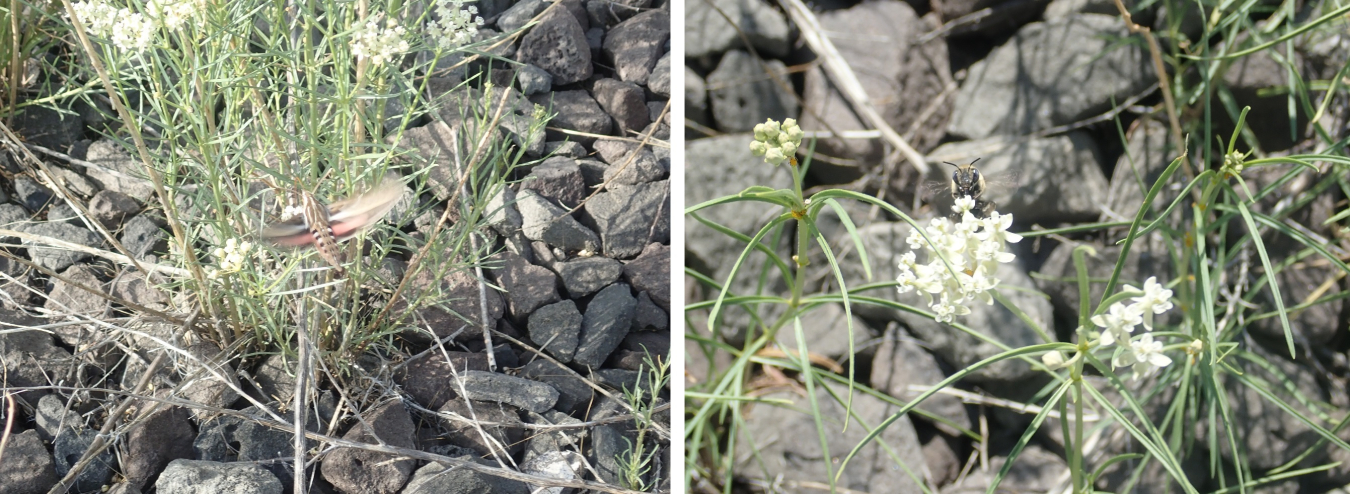Milkweed thrives at New Mexico site, nourishing butterfly species that helps fertilize most of the flowering plants that humans rely on for food.
March 14, 2022With its brilliant black-and-orange wings and indispensable role as a pollinator, the Monarch butterfly is one of the most easily recognizable – and cherished – insect species in North America. Celebrated for its beauty, revered for its role in nature, the Monarch butterfly is now drawing attention for being elusive. In 2020, the U.S. Fish and Wildlife Service designated Monarchs as a candidate species, which means its status is currently being reviewed to determine whether it warrants listing under the Endangered Species Act. The decline in Monarch populations could have devastating ramifications. Pollinators, insects and mammals that move pollen, help fertilize between 75 and 95 percent of flowering plants and bring humans one out of every three bites of food. Today, the Department of Energy (DOE) Legacy Management (LM) office is helping to identify and understand the dwindling Monarch populations – while supporting the environment in which these pollinators thrive.
“Monarchs are integral to the health of so many different ecosystems,” Emily Gaasche, an LM ecologist studying the species said. “Our intention is to promote knowledge and understanding of Monarch occurrence, habitat, breeding, biology and migration dynamics at LM sites.”
Each spring, hundreds of thousands of Monarchs leave California or Mexico. The Monarch migration, which spends winters in California and spreads across remote areas of the southwestern United States, is even harder to track and count. Those far-flung flight paths make sightings rare. So, when LM ecologists noticed large numbers of Monarchs onsite in Bluewater, New Mexico in 2019, they seized the opportunity to measure the under-researched group.
An LM ecologist walks along one of the transects and counts milkweed plants at the Bluewater, New Mexico disposal cell.
The LM ecologists observed both adult Monarchs and an abundance of naturally occurring horsetail milkweed. The plant is an ideal host for Monarchs: once consumed by the caterpillars, the plant’s chemical compounds make the Monarchs poisonous to most predators. Thus, the milkweed, which ecologists noticed was spread all over the disposal cell, nourishes and protects the population and is crucial to the success of the species.
Since eastern Monarchs are known to stop in the same location year after year, the ecologists hypothesized that western Monarchs might return to the site due to the plethora of milkweed habitat. Two years later, in late summer of 2021, a team of three ecologists returned to the field to perform a meticulous, noninvasive survey of the area. They hoped to estimate just how many Monarchs were calling Bluewater a temporary home – which would also help them to understand the western monarch population.
With only one week to conduct their survey, the ecologists first established evenly spaced observation paths, called transects, across the site and performed an area milkweed density survey by counting milkweed plants. Once the transects were examined, the team determined which sampling method would be the most efficient, adhere to the best scientific practices, and lead to the best data. Their pick? An observational approach that revealed the biodiversity thriving at Bluewater.
A Monarch caterpillar crawls along a milkweed plant at Bluewater.
Without removing any organisms, the team counted the number of caterpillars, adult Monarchs, and other species within 10-by-10-meter sampling areas scattered across the site.
“Our initial findings show there were roughly 0.7 – or about 1 – Monarchs present for every 10 square meters of milkweed,” Gaasche said, “which is really cool.”
Throughout the week, the ecologists recorded the presence of bumblebees, moths, smaller bees, beetles, and milkweed bugs, each of which play an important role in maintaining the local ecosystem. Gaasche emphasized the role of Monarchs as “canaries in the coal mine” in terms of understanding threat levels to other important pollinators.
An adult Monarch, its signature orange-and-black wings visible, alights on a plant at Bluewater.
“Monarchs have become whistleblowers,” Gaasche said. “As pollinators, Monarchs have a wide-ranging, beneficial influence. Their declining numbers often parallel declines for other pollinators that might not be as well studied.”
Pollinators evolve with the native plants that they nectar on, and those plants are best adapted to the local growing season, the climate, and the soil. If these habitats are degraded, the pollinators might not survive – and likewise, neither do other species in the area.

At left, hummingbird moth (Hyles lineata) circles a milkweed plant at Bluewater. At right, a native bumblebee pollinates a milkweed flower.
The team expects their full report to be published in early spring – and given the ecologists’ noninvasive approach, they believe their method could be easily replicated at Bluewater and elsewhere to measure pollinator populations.
“We believe it’s important that we get back out there and continue to perform these surveys and monitor these pollinators,” Gaasche said. “We hope to use our findings as a steppingstone towards developing a standardized field sampling protocol that can be repeated across other LM sites.”
Once published, the ecologists’ findings may help shed light on one of the most mysterious insect migrations in the country, raising awareness of its fragile population numbers – all while setting a precedent for scientific study across LM sites.

